The era of static, one-size-fits-all websites is fading. In its place: dynamic, data-driven experiences that adapt in real-time to the user in front of them. Whether you’re serving a procurement manager on a third visit or a first-time founder browsing at midnight on mobile, website personalisation ensures every interaction is contextually relevant as well as commercially impactful.
For UK-based B2B brands, this isn’t just a nice-to-have. It’s a growth necessity. Longer sales cycles, diverse buying committees, and rising CAC mean that frictionless, high-converting journeys are a strategic advantage. And personalisation is how you build them.
In this guide, we’ll move beyond generic “Hi [FirstName]” tactics. You’ll get a complete playbook on the frameworks, technologies, and tactics behind effective personalisation in 2025. From real-time behavioural segmentation to cross-device orchestration, we’ll show you what works and how to do it compliantly. And throughout, we’ll share how Common Ground helps ambitious teams turn personalisation into real pipeline growth.
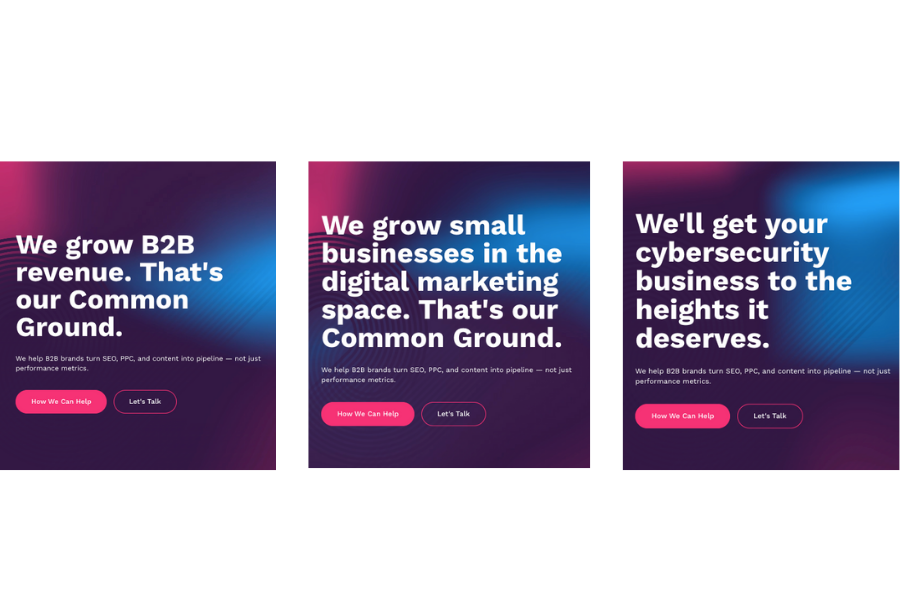
What Is Website Personalisation?
Definition and Scope
At its core, website personalisation is the practice of tailoring a user’s on-site experience based on who they are, what they’ve done, and what they’re likely to need next. Unlike static websites that serve the same content to everyone, personalised sites adapt in real-time, modifying headlines, calls to action, layouts, and product recommendations to match each visitor’s context.
This goes beyond just known users. Anonymous visitor personalisation enables brands to deliver relevance from the first touch, using signals like device type, time of day, location, and referral source. A first-time mobile user arriving from a LinkedIn ad might see a different homepage layout than a returning visitor from an organic search.
Modern personalisation spans:
- Content blocks that change based on behavioural history
- Layout variations for different devices or visitor types
- CTA personalisation tied to the funnel stage or industry
- Product and content recommendation engines that learn from user signals
Why Personalisation Matters
According to McKinsey, 71% of consumers expect personalised interactions, and 76% feel frustrated when they don’t get them (source). For marketers, that expectation is an opportunity. Brands that lead in personalisation generate 40% more revenue from those activities than average players.
For B2B, the stakes are even higher. With longer, multi-stakeholder journeys, repeat visits, and greater content consumption before contact, personalisation aligns perfectly with the buying process. It:
- Increases engagement and time on site
- Reduces bounce rates and drop-offs
- Drives stronger attribution and pipeline influence
Whether you’re serving tailored USPs to industry-specific visitors or adjusting calls to action based on funnel stage, personalisation is how you turn visits into velocity.
Personalisation Strategy: Frameworks and Fundamentals
To get personalisation right, you need more than plugins or page rules. You need a strategy that connects data, tech, and content to user intent. This section unpacks the key frameworks and foundational systems that power effective, scalable personalisation.
Core Personalisation Frameworks
If you want personalisation to drive results, not just activity, you need a strategic lens. One that connects tactics to intent. That’s where the R4 model comes in:
Recognise, Remember, Recommend, and Relevance.
It breaks down like this:
- Recognise who’s on your site. Look at their device, referral source, and time of visit.
- Remember their previous sessions, content interactions, and behaviour over time.
- Recommend the next step, such as a relevant case study, demo, or comparison.
- Relevance keeps it all in check by ensuring every message matters to the visitor.
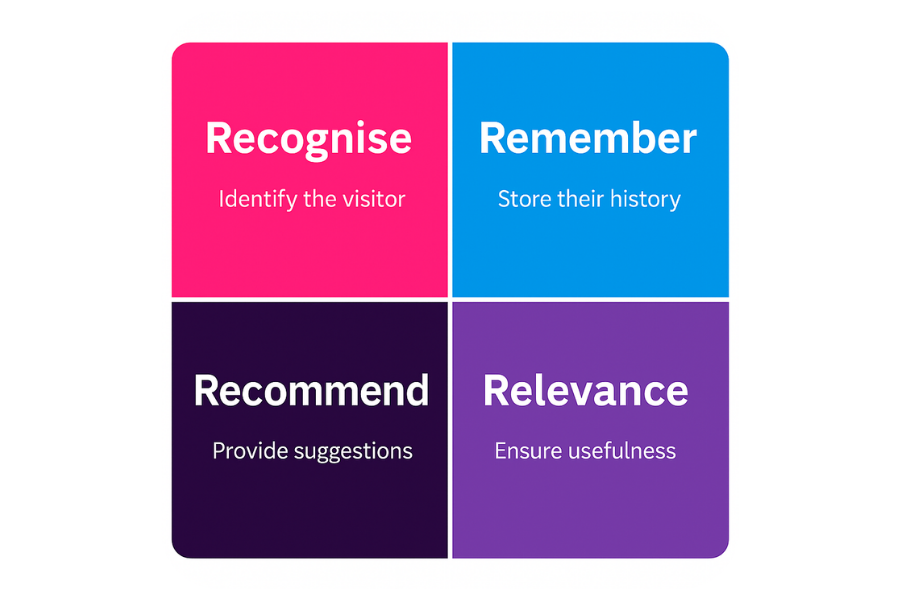
This model aligns naturally with the funnel:
- At the top, focus on recognising visitor intent and source.
- In the middle, use remembered behaviours to personalise mid-funnel content.
- At the bottom, recommend assets that accelerate decision-making.
The key is knowing that automation doesn’t equal intelligence. Tools can deliver content on cue, but it’s your team’s judgment that makes it work. Strategy defines what’s worth showing, when, and to whom. This is why Common Ground’s tailored approach ensures success by combining behavioural data and commercial context, making your personalisation work for the user and the business.
Data Sources That Power Personalisation
Strong personalisation relies on smart, actionable data. Whether you’re tailoring content for known leads or adapting CTAs for anonymous traffic, it starts with understanding where your insights come from and how to use them.
Your foundational tools are:
- CRM for known contacts. Useful for the deal stage, job title, and previous touchpoints.
- CDP to create unified visitor profiles that reflect multiple channels.
- DMP for third-party segments and anonymous visitor targeting.
- Analytics platforms to capture live behavioural signals like time on page and interaction depth.
To deepen targeting, brands often apply enrichment:
- Firmographic data reveals industry, revenue, or tech stack, especially helpful in B2B.
- Demographic data clarifies role, location, and seniority.
- Psychographic data explores preferences, values, and pain points.
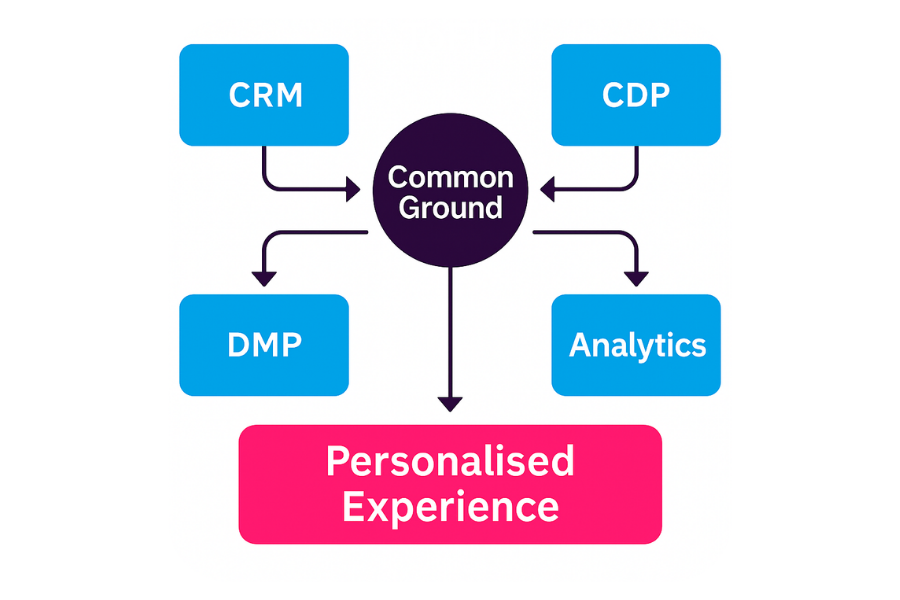
This unlocks advanced segmentation. For example, a CFO visiting your pricing page after downloading a strategic guide shows more intent than a new visitor skimming a blog post. They need different content and a different journey.
Types of Website Personalisation (with Examples)
Personalisation isn’t one-size-fits-all. The right approach depends on your audience, your data, and your goals. This section breaks down the most common (and most effective) types of personalisation, along with examples to show how they work in practice.
Behavioural and Contextual Personalisation
Not all visitors land on your site with the same intent or in the same context. That’s where behavioural and contextual personalisation come in. These tactics adapt on-site content based on real-time inputs like device, time, referrer, or user behaviour.
Contextual examples include:
- Showing location-specific content or delivery timelines
- Adjusting CTAs for mobile vs. desktop users
- Surfacing different hero messages based on the time of day or week
Behavioural examples include:
- Highlighting different USPs for new vs. returning B2B visitors
- Nudging users back to content they’ve previously viewed
- Tailoring homepage modules based on pages visited or scroll depth
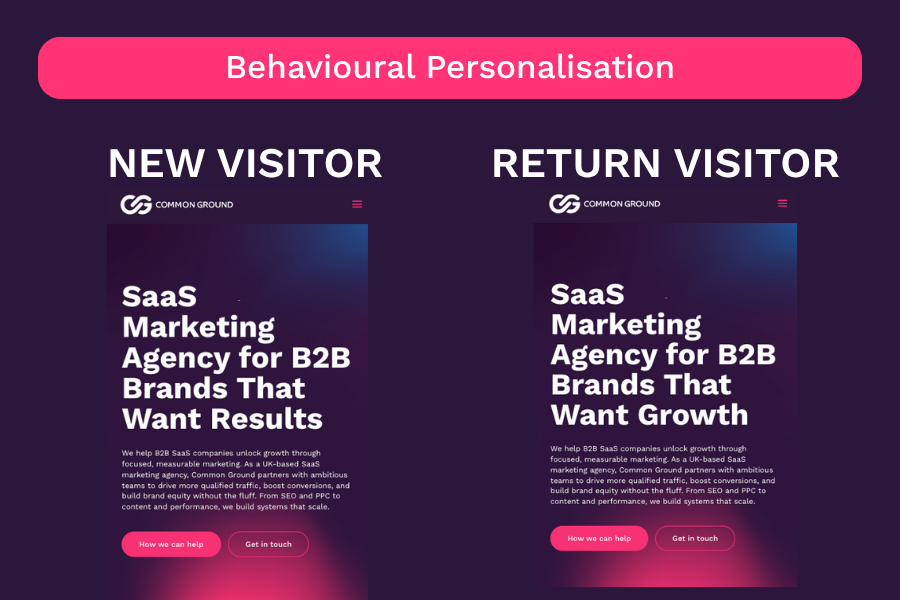
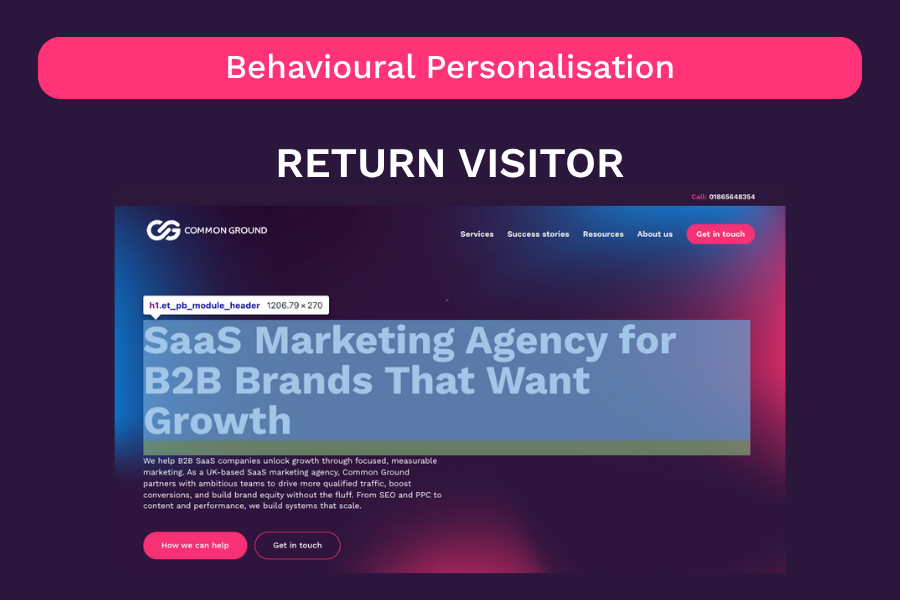
This type of personalisation often delivers early wins, especially for anonymous visitors or lightly enriched traffic.
Dynamic Content and Product Recommendations
Dynamic content lets your website update itself in real-time, without dev intervention. It’s especially powerful when combined with recommendation engines, which surface high-converting content based on behaviour.
B2B example: A SaaS landing page that adapts based on campaign source. Visitors from a “security-focused” LinkedIn ad see case studies and messaging aligned to compliance.
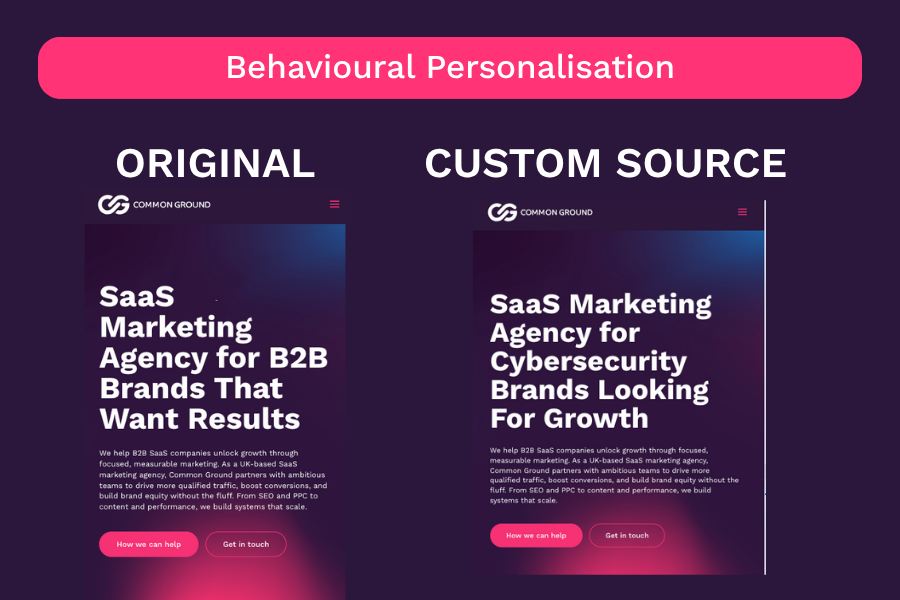
B2C example: A returning shopper sees products they previously browsed, plus related items powered by AI.
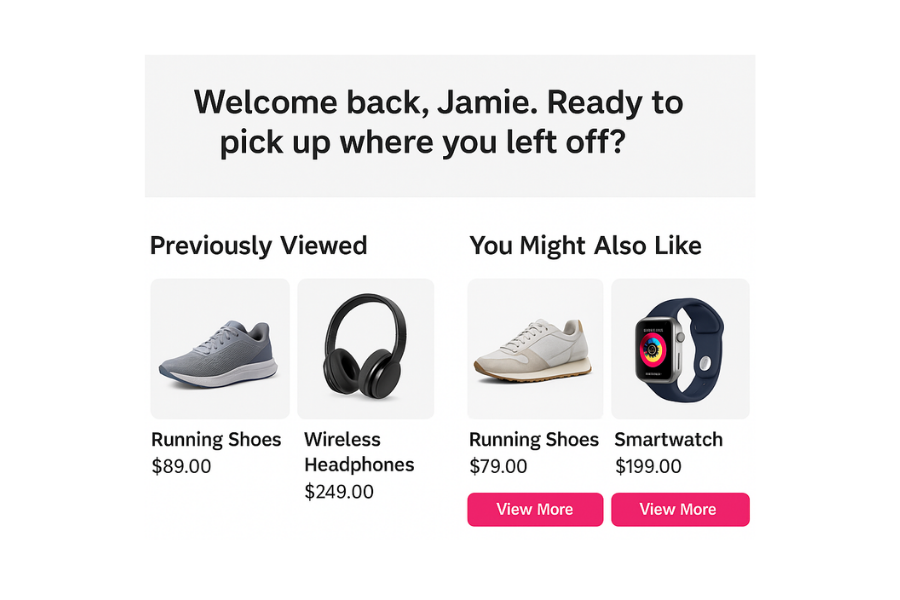
At Common Ground, we often deploy this with adaptive landing pages for paid media. A single page might present different testimonials, case studies, or feature highlights depending on the audience segment and UTM parameters. Same page. Smarter results.
One-to-One and Hyper-Personalisation at Scale
This is the sharp end of personalisation: predicting what someone needs before they know it. Using AI and machine learning, brands can personalise content down to the individual based on predicted intent, role, industry, or journey stage.
Examples include:
- Customising pricing pages based on company size or inferred budget
- Showing different product tours based on job title
- Sequencing nurture content in real time based on actions taken

While this level of personalisation requires deeper data infrastructure, the upside is clear: highly relevant journeys that reduce drop-off and accelerate conversion.
Best Practices for Effective Personalisation
Personalisation can be powerful, but only when it’s done well. Without a structured approach, it’s easy to overdo, underdeliver, or miss the mark entirely. This section covers the tactical best practices that separate shallow personalisation from scalable, strategic performance.
Testing, Optimisation, and Performance
Personalisation is only as strong as its feedback loop. To improve outcomes over time, you need to test, measure, and adapt.
Start by comparing:
- A/B testing, where two versions are shown to different audiences
- Multivariate testing, where multiple elements are tested simultaneously
- AI-led personalisation, which learns and optimises in real time based on performance data
The right model depends on scale, traffic volume, and available data. For smaller teams, rule-based or A/B testing gives control. For enterprise or high-traffic brands, machine learning can drive smarter iterations.
Key metrics to track:
- Conversion rate uplift (per segment)
- Engagement (time on site, page views)
- Micro-conversions (form interactions, demo video plays)
- Attribution lift (pipeline sourced or influenced)
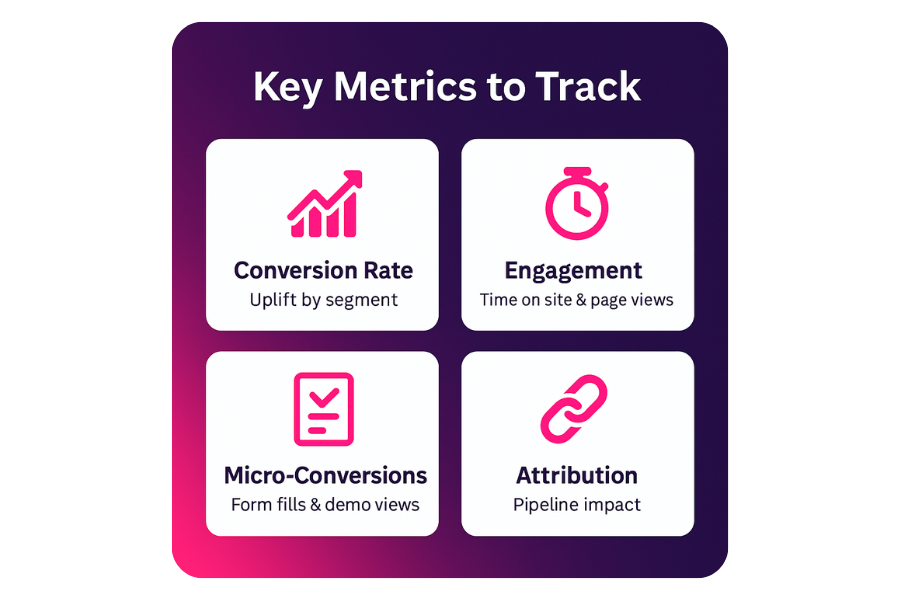
The goal? Learn what matters to each audience slice, and iterate without adding friction.
Privacy, Consent, and Compliance
Personalisation lives or dies by trust. That means handling data with clarity and care, especially in a post-GDPR, post-CCPA landscape.
Best practices include:
- Transparent cookie consent flows that are user-friendly and compliant
- Clear opt-in design that doesn’t rely on dark patterns
- Data minimisation, storing only what’s necessary
- Consent management platforms (CMPs) to track and audit preferences
Crucially, communicate the value exchange. Tell users why you’re asking for their data and what they’ll get in return. “Get tailored resources for your industry” beats “We use cookies.”
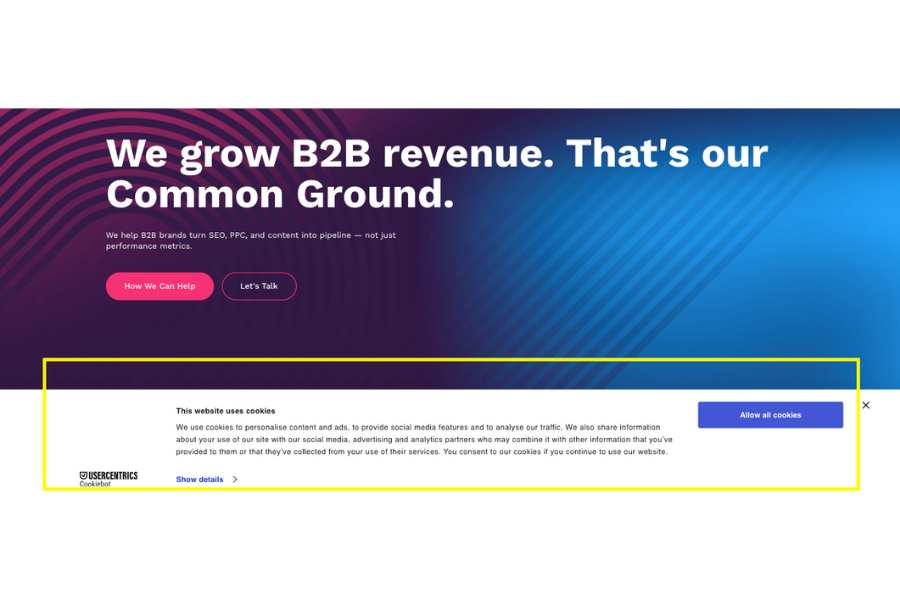
Omnichannel and Cross-Device Consistency
Personalisation shouldn’t break when a user switches from desktop to mobile or from web to email. Cross-device consistency is essential for building trust and maintaining momentum across the journey.
Key tactics:
- Unify user profiles across platforms using CDPs or identity graphs
- Stitch sessions to maintain context across visits and devices
- Sync messaging across your various channels, including website, email, chatbot, and push, to avoid fragmentation
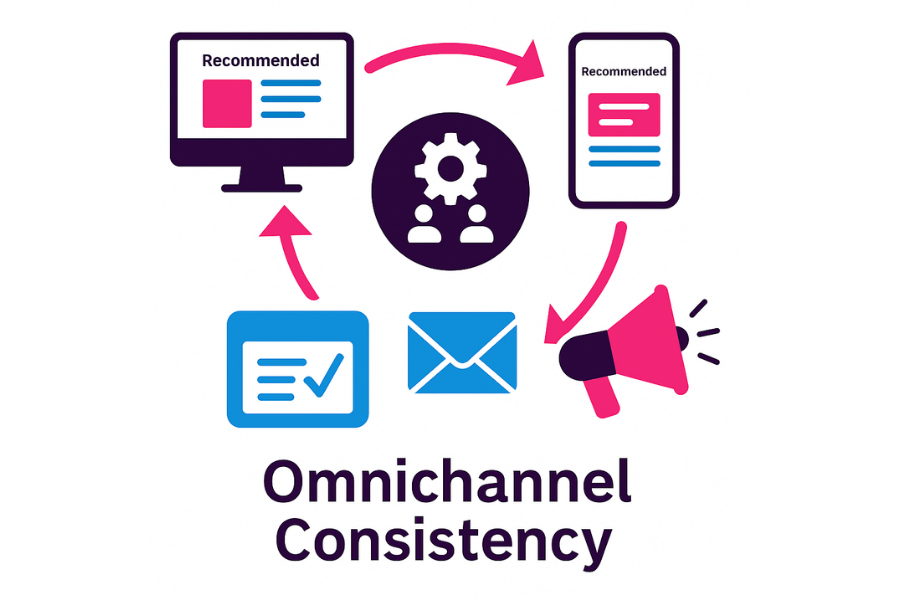
For example, if a returning visitor has downloaded a guide via email, the website should reflect that behaviour. Serving the same content again is a wasted touch in B2B marketing. Serving the next best asset? That’s good orchestration.
Common Personalisation Pitfalls (and How to Avoid Them)
Personalisation done well builds trust and boosts performance. Done poorly, it breaks journeys, creeps out users, or worse, it just doesn’t work. This section outlines the most common traps teams fall into and how to avoid them.
Overdoing It
Just because you can personalise something doesn’t mean you should. Overly granular personalisation, like dropping a user’s name or company in a headline without context, can feel intrusive, not insightful.
Avoid this by:
- Testing perception: Would you find this personalisation helpful or unnerving?
- Keeping it relevant to the user’s intent, not just their identity
A good rule: If it doesn’t enhance the user journey, leave it out.
Lack of Context
Greeting a user by name while offering irrelevant products or content creates dissonance. Personalisation should guide, not distract.
Avoid this by:
- Matching messaging to behavioural signals and funnel stage
- Ensuring all personalised elements serve a clear purpose
Context isn’t optional. Without it, personalisation becomes noise.
Treating It as a Tactic, Not a Strategy
Many brands treat personalisation as a plug-in, a one-off A/B test or campaign asset. But the real gains come from long-term thinking and infrastructure investment.
Avoid this by:
- Building a personalisation roadmap tied to business goals
- Investing in scalable systems like CDPs or behavioural tagging
- Treating personalisation as part of your broader digital experience, not a bolt-on
Shortcuts might deliver quick wins. But sustainable impact comes from treating personalisation as a strategic capability.
Ignoring Edge Cases
When personalisation logic fails, whether it’s due to missing data, technical errors, or rare user behaviours, it can create jarring experiences.
Avoid this by:
- Creating fallbacks for all personalised components
- Regularly testing across device types, browsers, and visitor states
- Logging and auditing personalised journeys for anomalies
Unknown users, misfiring segments, or expired cookies shouldn’t break the experience. Plan for the edges as well as the core.
How to Get Started with Website Personalisation
You don’t need an enterprise stack or six months of dev time to get going. The smartest teams start with simple, measurable experiments that improve user experience from day one. This section covers how to get traction quickly, then scale with purpose.
Start with Quick Wins
Not every journey needs to be powered by AI. Some of the most effective personalisation tactics are also the most achievable.
Here are three low-lift, high-impact examples to launch with:
1. Adjust your hero CTA by traffic source: For instance, show “See why enterprises choose us” to users arriving from an enterprise-focused PPC ad.
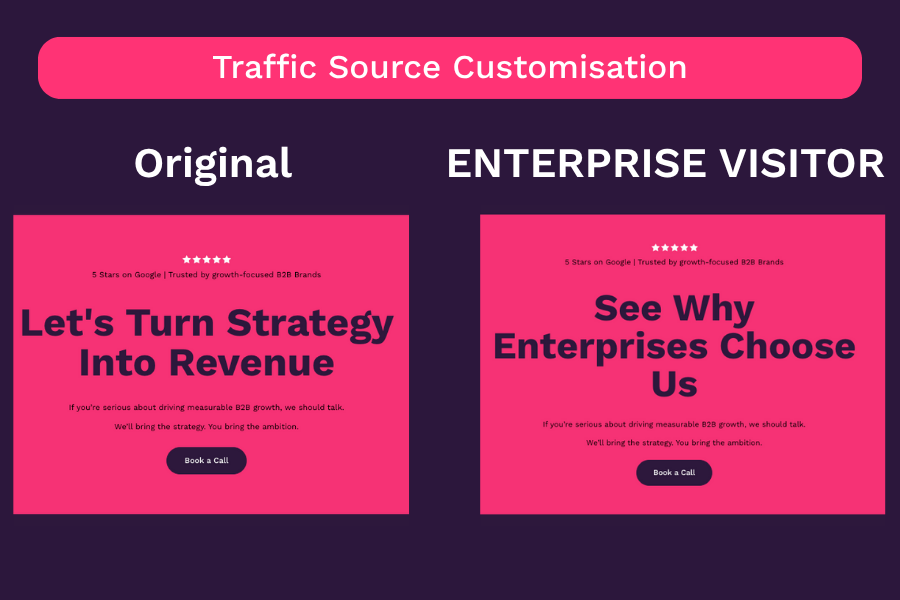
2. Rotate testimonials based on industry or job title: Use inferred firmographic data to highlight relevant case studies and quotes.
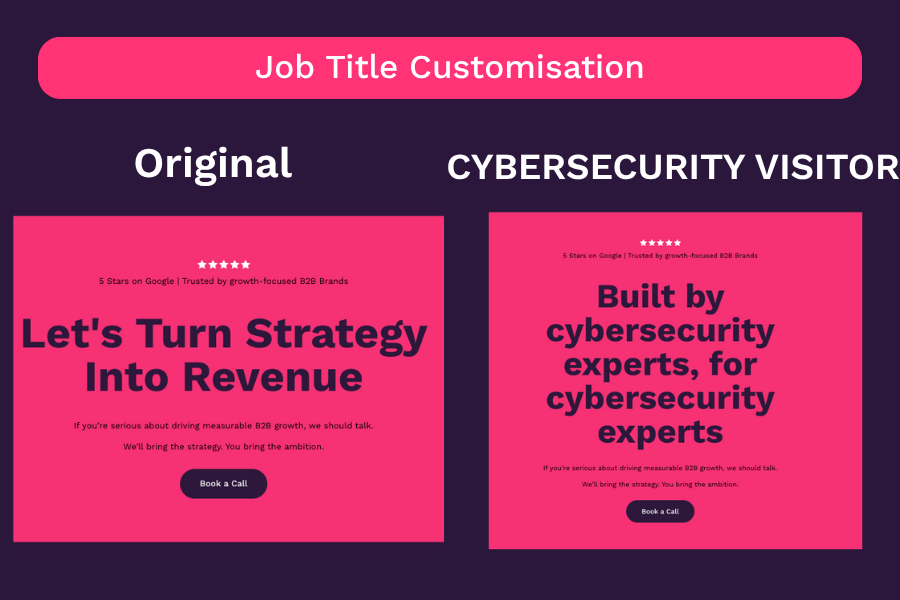
13. Tailor messaging based on company size: Lightweight IP tools or LinkedIn referrer data can help you serve startup-friendly or enterprise-ready copy.
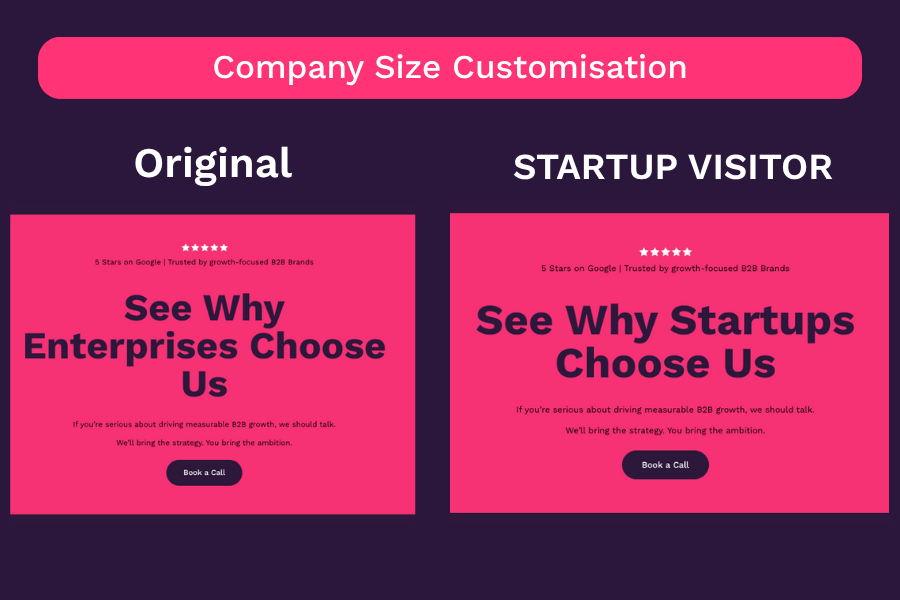
These tweaks don’t require a full platform rebuild. They’re focused, fast, and measurable, which is ideal for getting internal buy-in.
Build a Roadmap that Scales
Once you’ve proven value, it’s time to expand. A phased approach helps you grow with control, not chaos.
Crawl
- Rule-based changes tied to UTM tags, geolocation, or device type
- Example: Swap messaging for mobile visitors or highlight regional offers
Walk
- Segment content using data from your CRM or CDP
- Serve dynamic modules based on job role or funnel stage
- Trigger mid-funnel CTAs using past behaviours like whitepaper downloads
Run
- Deploy predictive personalisation using machine learning
- Orchestrate full journeys across web, email, chatbot, and app
- Optimise content in real time based on live performance data
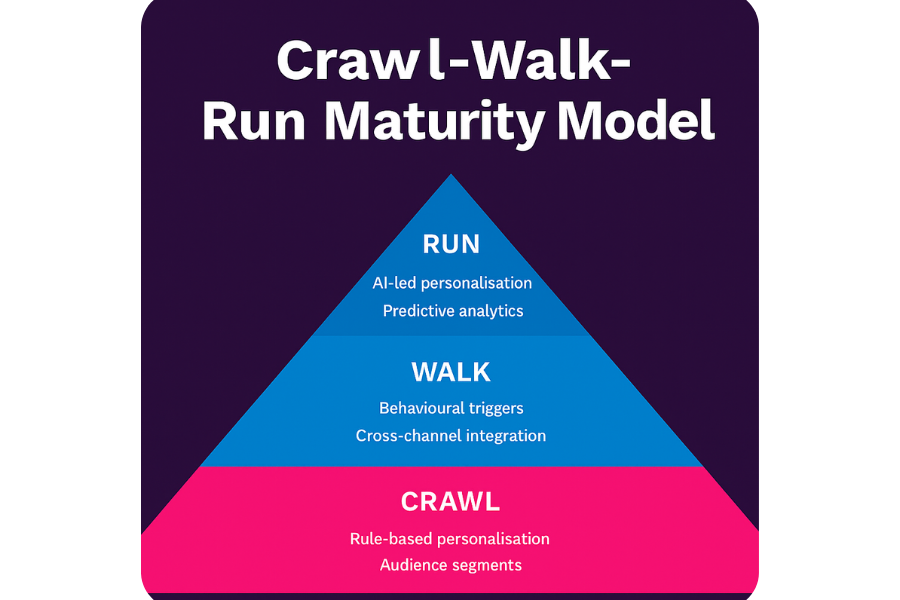
Make sure each phase has its own KPIs. Early wins might focus on engagement and bounce rate. Later stages should measure pipeline influence and full-funnel attribution.
Scaling doesn’t mean doing everything at once. It means layering intelligence at the right pace, based on what works.
Final Thoughts: Personalisation as a Growth Lever
Think about the last time a website felt like it “just got” what you were looking for. You didn’t have to hunt. You didn’t have to click around hoping to land on something useful. It was there because the site was built to listen and respond.
That’s the real value of personalisation. It cuts through the noise, not by shouting louder, but by showing up with the right thing at the right moment.
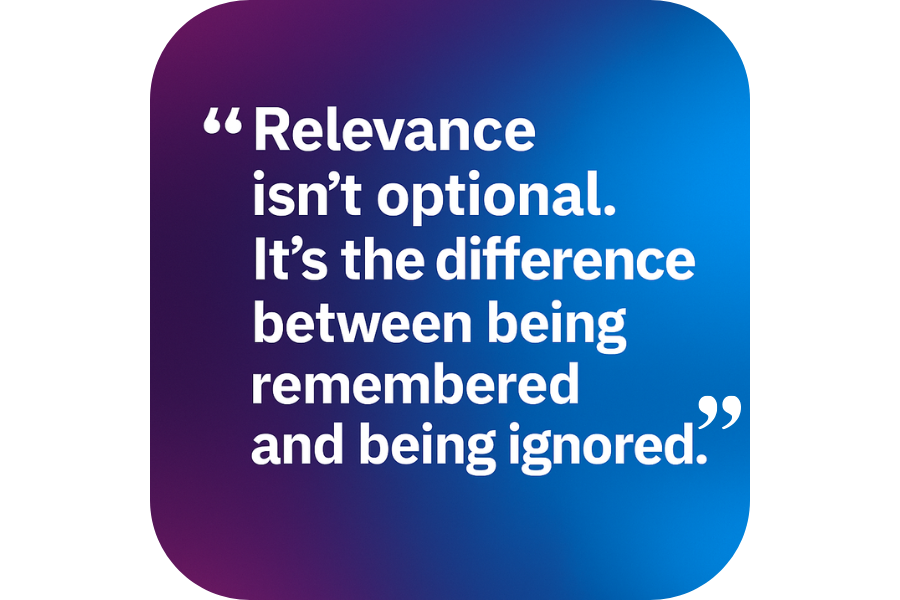
For most B2B teams, especially the ones dealing with long cycles and layered decision-making, this isn’t a shiny extra. It’s how you stay relevant. It’s how you stay remembered.
And it doesn’t have to be complicated. You start by fixing the small stuff. Learn what works. Build from there. Before long, personalisation stops feeling like a “project” and starts becoming part of how you think.
The tech helps, sure. But the magic? That’s in the timing, the context, and the care behind it.
What you will learn in this post
5 Stars on Google | Trusted by growth-focused B2B Brands
Let’s Turn Strategy Into Revenue
If you’re serious about driving measurable B2B growth, we should talk.
We’ll bring the strategy. You bring the ambition.
Connect
More about the author

Shane O'Hare
Client Partner
A master of marketing with more than a decade of experience in the digital game, Shane is our most senior SEO specialist and leads up client relations. If he isn't helping out our clients or understanding their needs, he's probably on YouTube learning to fix something in his house.